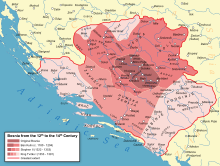
Back Усора Bulgarian Usora (oblast) BS Usora (zemlja) Spanish Usora (région) French Usora i Soli Croatian Усора (область) Russian Usora i Soli Serbo-Croatian Усора (област) Serbian
| Zemlja Usora Usora | |||||||||
|---|---|---|---|---|---|---|---|---|---|
| Zemlja (Land) of Bosnian Banate, Bosnian Kingdom | |||||||||
| earliest mention 20 July 1244–after 1463 | |||||||||
 Zemlja's in the development of the medieval Bosnian state. | |||||||||
| Capital | Srebrenik, Tešanj | ||||||||
| Area | |||||||||
| • Coordinates | 44°20′30″N 17°16′10″E / 44.341667°N 17.269444°E | ||||||||
| Status | Zemlja (Land) | ||||||||
| Government | |||||||||
| • Type | Feudal | ||||||||
| Duke of Bosnia or Grand Knyaz of Bosnia | |||||||||
• 1241–1247 | Matej Ninoslav, | ||||||||
• 1353-1377 | Tvrtko Ivanić, | ||||||||
• 1377-1395 | Vlatko Tvrtković, | ||||||||
• 1395-1400 | Vučina Vlatković, | ||||||||
• 1400-1424 | Vukmir Zlatonosović, | ||||||||
• 1424-1430 | Vukašin Zlatonosović, | ||||||||
• 1444-1463 | Tvrtko Stančić; | ||||||||
| Historical era | Medieval Bosnia | ||||||||
• Established | earliest mention 20 July 1244 | ||||||||
• Disestablished | after 1463 | ||||||||
| Contained within | |||||||||
| • Banate | Banate of Bosnia | ||||||||
| • Kingdom | Kingdom of Bosnia | ||||||||
| Subdivisions | |||||||||
| • Type | Župa | ||||||||
| • Units | Terra Tolis, Župa Modnna, Župa Nenavište, Župa Tešanj, Župa Gradačac, Župa Visori, Župa Koraj, Župa Ukrinica; later Župa Soli, Župa Sapna, Župa Zaušije; | ||||||||
| |||||||||
| Today part of | Bosnia and Herzegovina | ||||||||
| History of Bosnia and Herzegovina |
|---|
 |
|
|
Usora (Latin: Vozora, Hungarian: Ózora) was important zemlja (transl. land; feudalna oblast transl. feudal region) of the medieval Bosnian state, first banate and later kingdom, although it also had some periods outside its jurisdiction and royal authority, when it was connected with neighboring banates of Slavonia, or Mačva at times. The administrative seat of this zemlja was Srebrenik, which also served as residence for its rulers for entire period of existence of the medieval Bosnian state.[1] It took its name from the river Usora.
- ^ Anđelić 1982, pp. 237–238.
© MMXXIII Rich X Search. We shall prevail. All rights reserved. Rich X Search